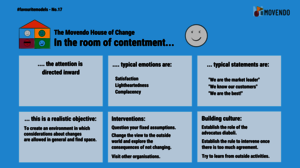#favouritemodel No.17 - House of Change - Contentment

The model was developed by Swedish psychologist Claes F. Janssen and his team. It is based on findings described back in 1969 by Elisabeth Kübler Ross and transfers them to the emotional and mental phases that people - and organizations - go through in change processes.
In today's world, constant change and transformation are part of the reality for every company and its employees. So, it's good that we humans fundamentally love change and even actively strive for it at different times in our lives.
But changes often become a challenge for us when we have not initiated them ourselves and they hit us at a time when we are highly satisfied with our situation. Nothing would be more distant from us at that moment than to change something in the current state, let alone to abolish something that is important to us or that has proven itself so far as a routine, habit, process. Whoever confronts us with changes in such situations exactly meets us in the first room of C.F. Janssen's model: the "room of contentment".
People who spend time here are carefree, almost complacent, feel completely satisfied. The focus of their attention is more on the "inside" than the "outside." For example, information about competitors is ignored, bureaucratic behavior is observed, and there is no sense of urgency to consider any changes. Typically, statements can be heard such as: "We are the market leader", "We know our customers, better than they know themselves", "We are the best", "Never change a running system".
If a change or transformation process is then initiated, our emotional journey through the "House of Change" begins: With the moment of the announcement, we move counterclockwise through the four rooms. Starting with the room of contentment, each additional room also relates to an emotional state.
Important: Whether self-initiated or externally determined, each of us goes through the four rooms of the "House of Change" in the same order. However, the speed by which we go through the individual phases differs from person to person.
How does this #favouritemodel help you?
Leading people through change means, first of all, having an idea of the inner processes that people go through during a change, especially if they did not initiate the change themselves and the change means that they have to say goodbye to something that was important to them before. Change does not always mean a major transformation. The integration of a new team member or the introduction of a new business process are changes that also need your attention. The "House of Change" can support you as a basis for reflection and discussion. It helps you to assess where the members of your team find themselves emotionally and mentally in the change process and what support they need. You can also locate yourself, because you move through the four rooms too.
A realistic goal for preparing your employees for future change processes, especially in the space of satisfaction, is to create an environment in which considerations of change possibilities in general are allowed and find space.
Use the room of contentment, for example, to:
- consciously observe the outside world by visiting other companies and comparing their best practices with yours.
- regularly examine customer satisfaction.
- question routines from time to time and especially give "divergent" thinkers the opportunity to share their opinions and ideas.
The consequences of "doing nothing" in the room of contentment should be clear to everyone in your teams.











